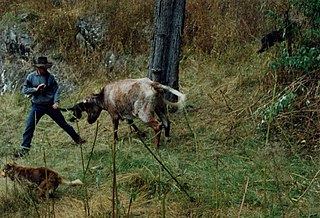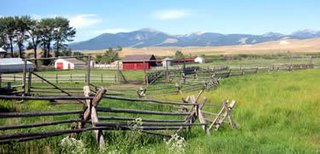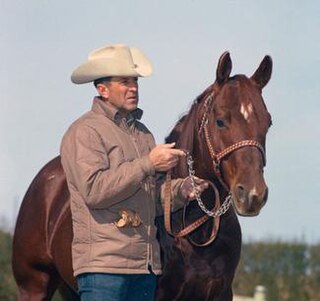
The American Quarter Horse, or Quarter Horse, is an American breed of horse that excels at sprinting short distances. Its name is derived from its ability to outrun other horse breeds in races of a quarter mile or less; some have been clocked at speeds up to 44 mph (70.8 km/h). The development of the Quarter Horse traces to the 1600s.

A cowboy is an animal herder who tends cattle on ranches in North America, traditionally on horseback, and often performs a multitude of other ranch-related tasks. The historic American cowboy of the late 19th century arose from the vaquero traditions of northern Mexico and became a figure of special significance and legend. A subtype, called a wrangler, specifically tends the horses used to work cattle. In addition to ranch work, some cowboys work for or participate in rodeos. Cowgirls, first defined as such in the late 19th century, had a less-well documented historical role, but in the modern world work at identical tasks and have obtained considerable respect for their achievements. Cattle handlers in many other parts of the world, particularly South America and Australia, perform work similar to the cowboy.

Cutting is a western-style equestrian competition in which a horse and rider work together before a judge or panel of judges to demonstrate the horse's athleticism and ability to handle cattle. Modern competition utilizes a 2+1⁄2 minute performance, called a "run." Each contestant is assisted by four helpers: two are designated as turnback riders, who help to keep cattle from running off to the back of the arena, the other two are designated as herd holders to keep the cattle bunched together and prevent potential strays from escaping into the work area. Cutting cattle are typically young steers and heifers that customarily range in size from 400 to 650 lb. They usually are of Angus or Hereford lineage though may be a mix of crossbred beef cattle, including Charolais or Brahman lineage.

A muster (Au/NZ) or a roundup (US/Ca) is the process of gathering livestock. Musters usually involve cattle, sheep or horses, but may also include goats, camels, buffalo or other animals. Mustering may be conducted for a variety of reasons including routine livestock health checks and treatments, branding, shearing, lamb marking, sale, feeding and transport or droving to another location. Mustering is a long, difficult and sometimes dangerous job, especially on the vast Australian cattle stations of the Top End, 'The Falls' (gorge) country of the Great Dividing Range and the ranches of the western United States. The group of animals gathered in a muster is referred to as a "mob" in Australia and a "herd" in North America.

Cattle drives were a major economic activity in the 19th and early 20th century American West, particularly between 1850s and 1910s. In this period, 27 million cattle were driven from Texas to railheads in Kansas, for shipment to stockyards in Louisiana and points east. The long distances covered, the need for periodic rests by riders and animals, and the establishment of railheads led to the development of "cow towns" across the frontier.

Team penning is a western equestrian sport that evolved from the common ranch work of separating cattle into pens for branding, doctoring, or transport.

Western riding is considered a style of horse riding which has evolved from the ranching and welfare traditions which were brought to the Americas by the Spanish Conquistadors, as well as both equipment and riding style which evolved to meet the working needs of the cowboy in the American West. At the time, American cowboys had to work long hours in the saddle and often over rough terrain, sometimes having to rope a cattle using a lariat, also known as a lasso. Because of the necessity to control the horse with one hand and use a lariat with the other, western horses were trained to neck rein, that is, to change direction with light pressure of a rein against the horse's neck. Horses were also trained to exercise a certain degree of independence in using their natural instincts to follow the movements of a cow, thus a riding style developed that emphasized a deep, secure seat, and training methods encouraged a horse to be responsive on very light rein contact.

A stock horse is a horse of a type that is well suited for working with livestock, particularly cattle. The related cow pony or cow horse is a historic phrase, still used colloquially today, referring to a particularly small agile cattle-herding horse; the term dates to 1874. The word "pony" in this context has little to do with the animal's size, though the traditional cow pony could be as small as 700 to 900 pounds and less than 14 hands high.
The National Cutting Horse Association is a non-profit equestrian organization headquartered in the US. Their primary purpose is to promote and sponsor cutting events. The association was founded in 1946 at the Southwestern Exposition and Fat Stock Show. The first NCHA sponsored cutting horse competition was held that same year in Dublin, Texas.

The Spade Ranch is a large cattle ranch located in the Sandhills of western Nebraska between the towns of Gordon and Ellsworth. Founded in 1888 by Bartlett Richards, the ranch was placed on the National Register of Historic Places in 1980.
A remuda is a herd of horses that ranch hands select their mounts from. The word is of Spanish derivation, for 'remount' i.e. "change of horses" and is commonly used in the American West.

The Fort Worth Stock Show & Rodeo is the oldest continuously running livestock show and rodeo. It has been held annually in Fort Worth, Texas since 1896, traditionally in mid-January through early February. A non-profit organization, the Stock Show has provided millions of dollars in grants and scholarships in its tenure and continues to provide hundreds of thousands of dollars annually to assist the future leaders of agriculture and livestock management.

A ranch is an area of land, including various structures, given primarily to ranching, the practice of raising grazing livestock such as cattle and sheep. It is a subtype of a farm. These terms are most often applied to livestock-raising operations in Mexico, the Western United States and Western Canada, though there are ranches in other areas. People who own or operate a ranch are called ranchers, cattlemen, or stockgrowers. Ranching is also a method used to raise less common livestock such as horses, elk, American bison, ostrich, emu, and alpaca.
Dual Peppy is a 1992 sorrel stallion registered with the American Quarter Horse Association (AQHA). He is sired by Peppy San Badger, and out of the mare Miss Dual Doc by Doc's Remedy. Dual Peppy qualified for the AQHA World Show during the 1997-1998 show season, and earned the title "1998 AQHA Reserve World Champion Senior Cutting Horse". In 1998-1999, he competed as a novice horse in National Cutting Horse Association (NCHA) events and earned the title "NCHA World Champion $10,000 Novice Cutting Horse." Dual Peppy, bred by the late Greg Ward, is the second of four full brothers in the Dual Pep line, which also includes Dual Pep, Mister Dual Pep and Dually Pep, all of whom have been successful horses in their own right. Ward broke, trained and showed Dual Peppy until he was sold in January 1998 to Rick and Sherry Brunzell of the Dual Peppy Partnership located in Colorado.

Samuel Burk Burnett was an American cattleman and rancher from Texas, owner of the 6666 Ranch, and namesake of Burkburnett, Texas.

Matlock Rose, born Berry Matlock Rose (1924–2008), was a professional horse trainer for over 60 years. He established a reputation as an all-around cowboy and trainer of champions. Rose was often described as stonefaced, a man of few words, but long held the respect of his peers. He was referred to as a trainers' trainer, and considered a legend. He trained multiple AQHA world champions, five NCHA world champions, was inducted into the American Quarter Horse Hall of Fame in 2001, as well as both the NCHA Rider Hall of Fame and the NCHA Members Hall of Fame. The first famous cutting horse he trained was Jesse James and many other great horses followed but he was best known for training Peppy San and Peponita.

Fern Sawyer was an American cowgirl, rodeo champion, politician and inductee into the National Cowgirl Museum and Hall of Fame and the Rodeo Hall of Fame of the National Cowboy and Western Heritage Museum. She was the first woman to win the cutting horse competition at the 1945 Fort Worth Fat Stock Show and Rodeo. Sawyer was also the first woman appointed to the New Mexico State Fair Board. She was well known for her "flashy attire," according to the Santa Fe New Mexican. She lived in Crossroads, Lovington, and Nogal, New Mexico. She was also a charter member of the National Cutting Horse Association and the first director of the Girls Rodeo Association.
Fay Owen "Buster" Welch was an American cutting horse trainer and inductee into the NCHA Members Hall of Fame, American Quarter Horse Hall of Fame, National Cutting Horse Association Riders Hall of Fame and Texas Cowboy Hall of Fame. Buster was chosen as the recipient of the 2012 National Golden Spur Award for his "outstanding contributions to the ranching and livestock industry".

Kay Floyd was an American horse breeder who was the first woman ever to win two NCHA Futurity championships, albeit in the Non-Pro division. She also earned the title of 1988 NCHA Non-Pro World Champion, and in 1991 was inducted into the NCHA Rider Hall of Fame - Non-Pro Division. Floyd owned the stallion, Freckles Playboy (1973-2003), sired by Jewel's Leo Bars by Sugar Bars out of Gay Jay by Rey Jay, and bred by Marion Flynt. As of 2013, Freckles Playboy ranked 3rd on NCHA's list of all-time leading sires and maternal grandsire sires of champion cutting and performance Quarter Horses with offspring that have earned $24.56 million in NCHA competition. Among his champion offspring were Playfulena, the mare Floyd rode to win the 1987 NCHA Non-Pro Futurity, and Playboys Madera, the mare she rode to earn the title of 1988 NCHA Non-Pro World Champion.
Marion Flynt was a cattle rancher and owner of the Square Top 3 Ranch in Midland, TX., home to many legendary horses including two foundation cutting horse sires, Jewel's Leo Bars (Freckles) and Rey Jay. Flynt was known in cutting horse circles as "Mr. Cutting Horse". He holds the record as the longest serving president of the National Cutting Horse Association (NCHA),, having served a total of 12 years. Flynt was inducted into the NCHA Members Hall of Fame in 1977. He was the owner of Marion’s Girl, a 1948 bay Quarter Horse mare and twice NCHA World Champion Cutting Horse, trained and shown by Buster Welch.















